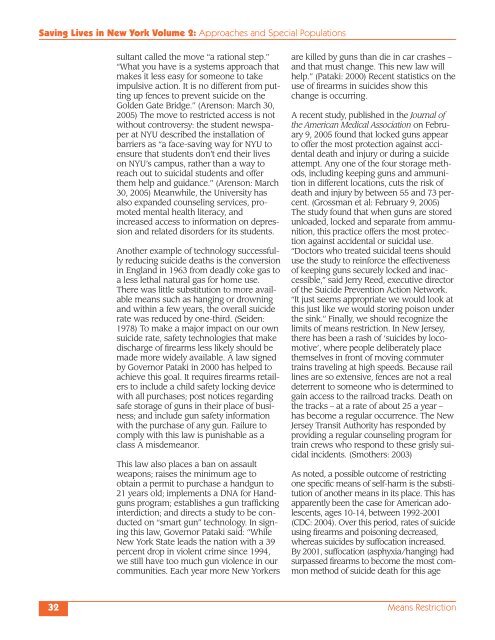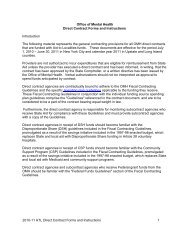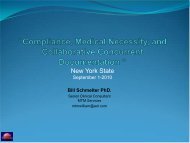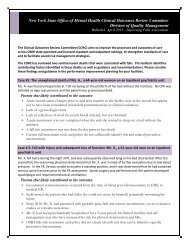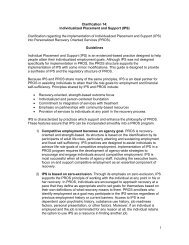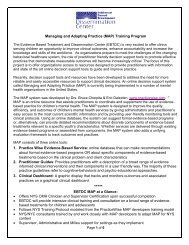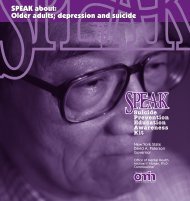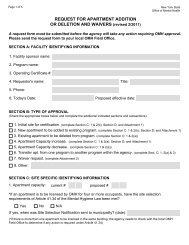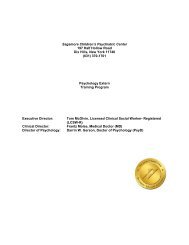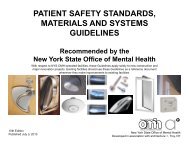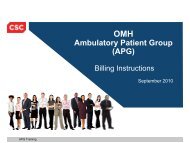Download - New York State Office of Mental Health
Download - New York State Office of Mental Health
Download - New York State Office of Mental Health
Create successful ePaper yourself
Turn your PDF publications into a flip-book with our unique Google optimized e-Paper software.
Saving Lives in <strong>New</strong> <strong>York</strong> Volume 2: Approaches and Special Populations<br />
sultant called the move “a rational step.”<br />
“What you have is a systems approach that<br />
makes it less easy for someone to take<br />
impulsive action. It is no different from putting<br />
up fences to prevent suicide on the<br />
Golden Gate Bridge.” (Arenson: March 30,<br />
2005) The move to restricted access is not<br />
without controversy: the student newspaper<br />
at NYU described the installation <strong>of</strong><br />
barriers as “a face-saving way for NYU to<br />
ensure that students don’t end their lives<br />
on NYU’s campus, rather than a way to<br />
reach out to suicidal students and <strong>of</strong>fer<br />
them help and guidance.” (Arenson: March<br />
30, 2005) Meanwhile, the University has<br />
also expanded counseling services, promoted<br />
mental health literacy, and<br />
increased access to information on depression<br />
and related disorders for its students.<br />
Another example <strong>of</strong> technology successfully<br />
reducing suicide deaths is the conversion<br />
in England in 1963 from deadly coke gas to<br />
a less lethal natural gas for home use.<br />
There was little substitution to more available<br />
means such as hanging or drowning<br />
and within a few years, the overall suicide<br />
rate was reduced by one-third. (Seiden:<br />
1978) To make a major impact on our own<br />
suicide rate, safety technologies that make<br />
discharge <strong>of</strong> firearms less likely should be<br />
made more widely available. A law signed<br />
by Governor Pataki in 2000 has helped to<br />
achieve this goal. It requires firearms retailers<br />
to include a child safety locking device<br />
with all purchases; post notices regarding<br />
safe storage <strong>of</strong> guns in their place <strong>of</strong> business;<br />
and include gun safety information<br />
with the purchase <strong>of</strong> any gun. Failure to<br />
comply with this law is punishable as a<br />
class A misdemeanor.<br />
This law also places a ban on assault<br />
weapons; raises the minimum age to<br />
obtain a permit to purchase a handgun to<br />
21 years old; implements a DNA for Handguns<br />
program; establishes a gun trafficking<br />
interdiction; and directs a study to be conducted<br />
on “smart gun” technology. In signing<br />
this law, Governor Pataki said: “While<br />
<strong>New</strong> <strong>York</strong> <strong>State</strong> leads the nation with a 39<br />
percent drop in violent crime since 1994,<br />
we still have too much gun violence in our<br />
communities. Each year more <strong>New</strong> <strong>York</strong>ers<br />
are killed by guns than die in car crashes –<br />
and that must change. This new law will<br />
help.” (Pataki: 2000) Recent statistics on the<br />
use <strong>of</strong> firearms in suicides show this<br />
change is occurring.<br />
A recent study, published in the Journal <strong>of</strong><br />
the American Medical Association on February<br />
9, 2005 found that locked guns appear<br />
to <strong>of</strong>fer the most protection against accidental<br />
death and injury or during a suicide<br />
attempt. Any one <strong>of</strong> the four storage methods,<br />
including keeping guns and ammunition<br />
in different locations, cuts the risk <strong>of</strong><br />
death and injury by between 55 and 73 percent.<br />
(Grossman et al: February 9, 2005)<br />
The study found that when guns are stored<br />
unloaded, locked and separate from ammunition,<br />
this practice <strong>of</strong>fers the most protection<br />
against accidental or suicidal use.<br />
“Doctors who treated suicidal teens should<br />
use the study to reinforce the effectiveness<br />
<strong>of</strong> keeping guns securely locked and inaccessible,”<br />
said Jerry Reed, executive director<br />
<strong>of</strong> the Suicide Prevention Action Network.<br />
“It just seems appropriate we would look at<br />
this just like we would storing poison under<br />
the sink.” Finally, we should recognize the<br />
limits <strong>of</strong> means restriction. In <strong>New</strong> Jersey,<br />
there has been a rash <strong>of</strong> ‘suicides by locomotive’,<br />
where people deliberately place<br />
themselves in front <strong>of</strong> moving commuter<br />
trains traveling at high speeds. Because rail<br />
lines are so extensive, fences are not a real<br />
deterrent to someone who is determined to<br />
gain access to the railroad tracks. Death on<br />
the tracks – at a rate <strong>of</strong> about 25 a year –<br />
has become a regular occurrence. The <strong>New</strong><br />
Jersey Transit Authority has responded by<br />
providing a regular counseling program for<br />
train crews who respond to these grisly suicidal<br />
incidents. (Smothers: 2003)<br />
As noted, a possible outcome <strong>of</strong> restricting<br />
one specific means <strong>of</strong> self-harm is the substitution<br />
<strong>of</strong> another means in its place. This has<br />
apparently been the case for American adolescents,<br />
ages 10-14, between 1992-2001<br />
(CDC: 2004). Over this period, rates <strong>of</strong> suicide<br />
using firearms and poisoning decreased,<br />
whereas suicides by suffocation increased.<br />
By 2001, suffocation (asphyxia/hanging) had<br />
surpassed firearms to become the most common<br />
method <strong>of</strong> suicide death for this age<br />
32 Means Restriction


